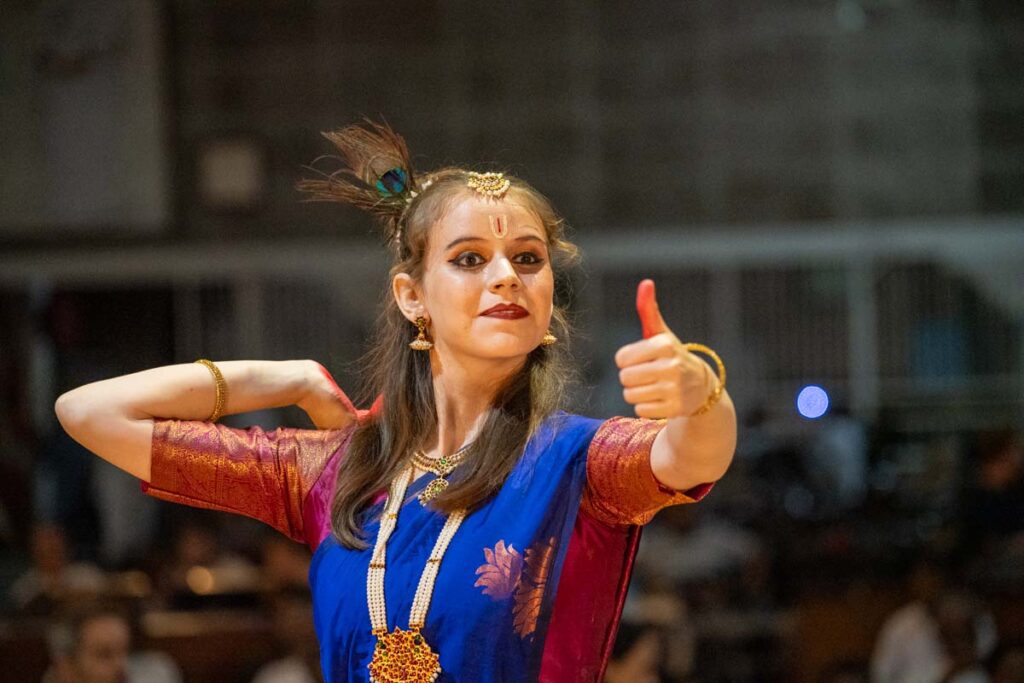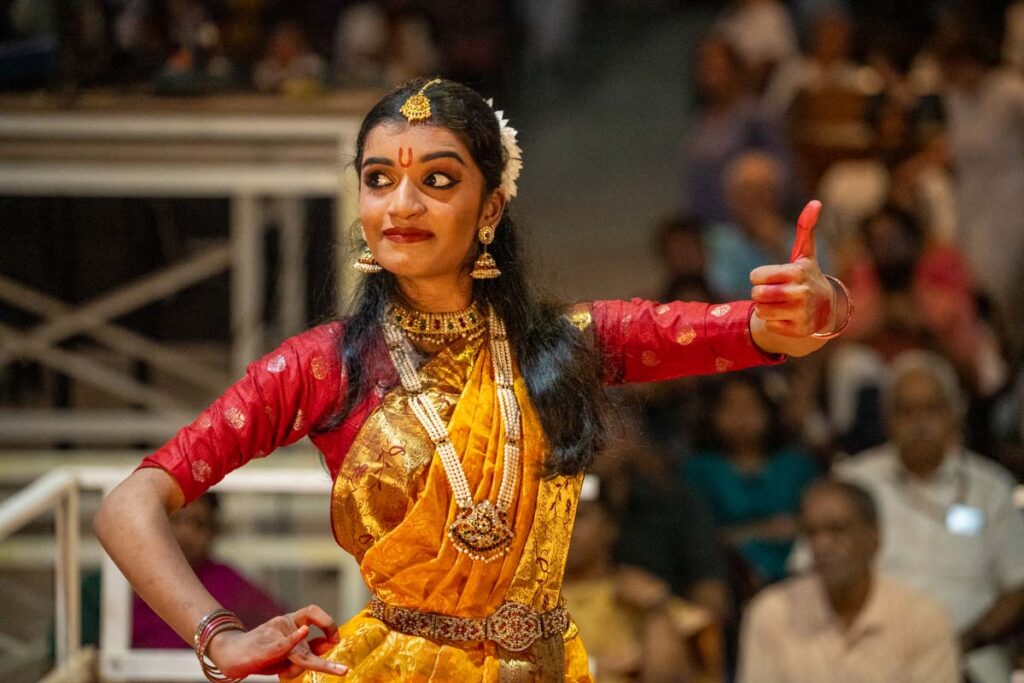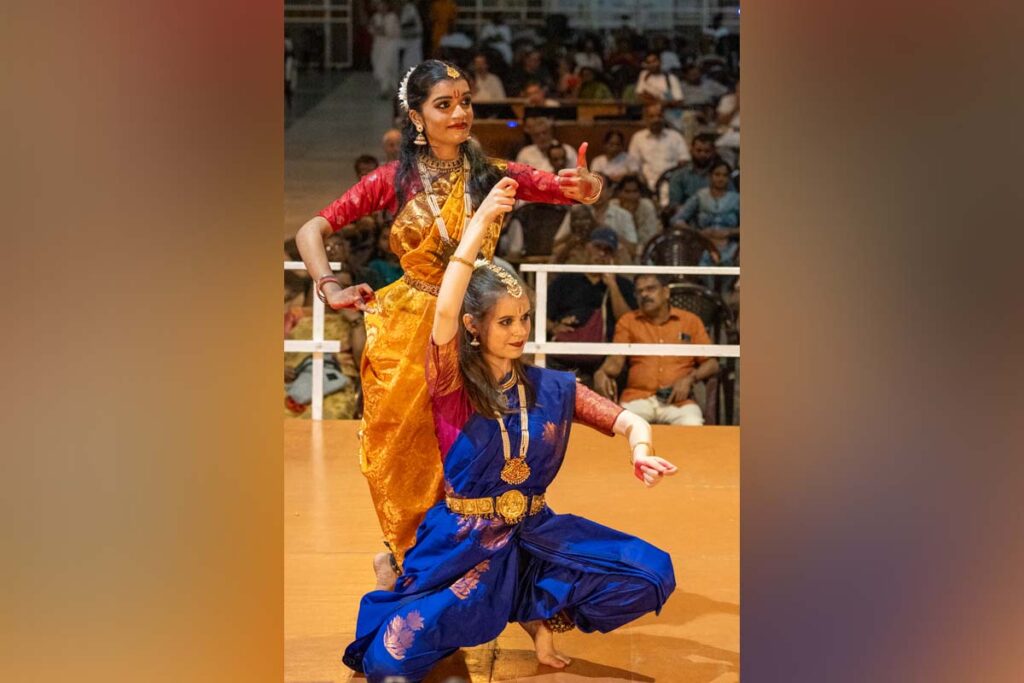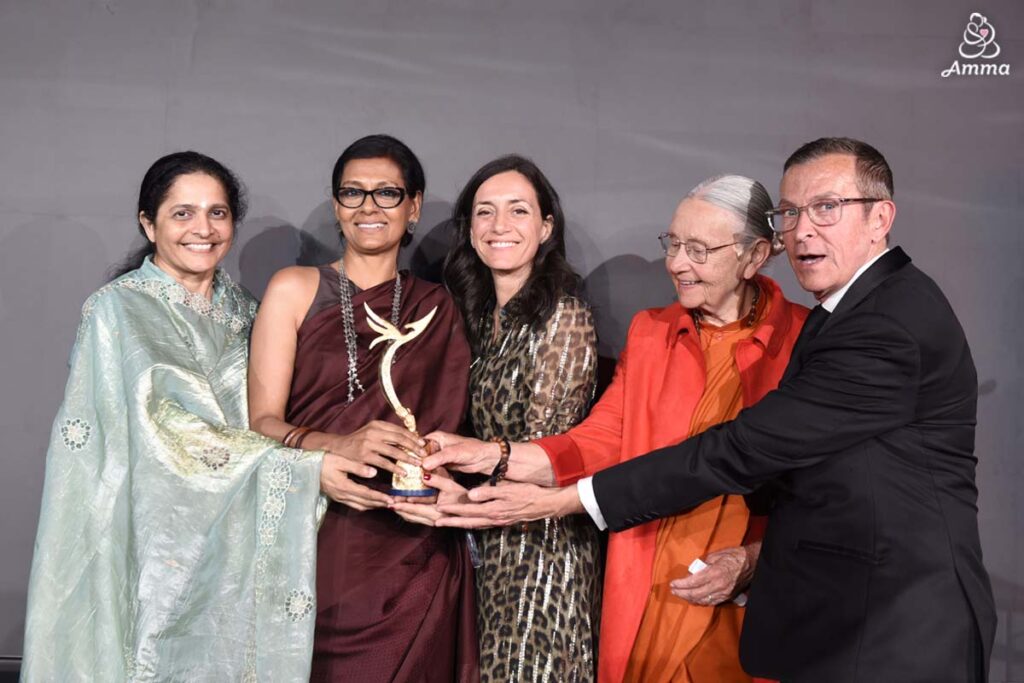On November 8, 2022, Amma began a unique challenge for all Ashram residents and visitors in Amritapuri. She welcomed everyone to come draw a slip of paper from a bag. Each piece contained one of the 700 slokas from the Srimad Bhagavad Gita. Participants then had to prepare a short satsang about its meaning, including personal learnings and experiences.
The Gita is known as the essence of all the scriptures of Sanātana Dharma, and yet shares this ancient knowledge in a way that is accessible to everyone. It contains a blend of diverse spiritual paths that include devotion, knowledge, action, and yoga so that people from all walks of life may choose what is best for them.
“The Bhagavad Gita is a wake-up call. It’s a song that wakes us up from our deep slumber. It’s like a cow chewing the cud. The cow eats the grass and then it lies down somewhere and chews it. It brings it back to its mouth, chews it well, and then swallows it,” explained Amma.
“In a similar manner, whatever information we have gathered from the scriptures needs to be contemplated, meditated upon, and then reflected. That was one of the purposes of this challenge. To cultivate such habits in my children.”
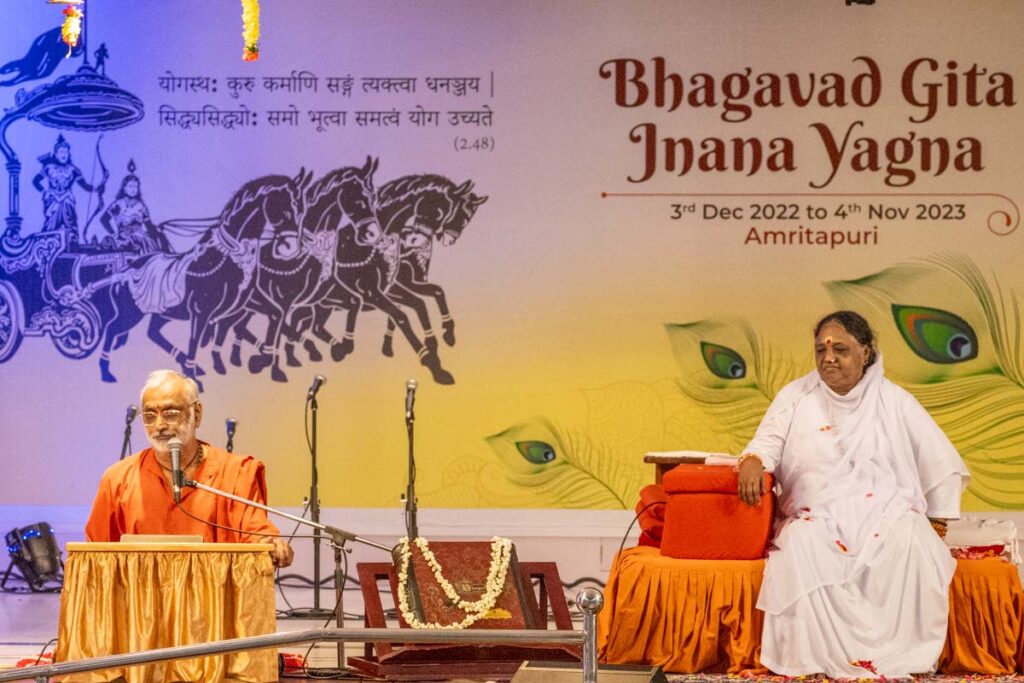
Delivery of the satsangs began on Gita Jayanti 2022, December 3rd, and transcended into an unimaginable spectrum of knowledge, devotion, and sharing. Each participant had the sentiment that the sloka they received, albeit by chance, was relevant for their individual natures and experiences. They were like a living Gita book, each one a verse in it.
On November 4, 2023, the last two verses were given, and the Bhagavad Gita Jnana Yajna came to a close through a grand celebration. Everyone who took part over these past 11 months, be it as speaker or listener, expressed that the learning they gained has opened their hearts and minds. Amma shared that this has to become a continuous practice.
“We cannot stop it here, because only through satsang will we attain the state of nissangatvam—non-attachment. And only by non-attachment will we reach nischala tattvam—no mind. First listen with your heart and soul. And then reflect, and then write,” said Amma.
“But non-attachment should not be misinterpreted as I have no love for others. That is not what it means. Instead, you see others as an extension of your own self. Everything becomes ‘I’. Not just the individual. Not just this body.
“All over the world, the common expression is ‘I love you’. It’s like love is imprisoned between ‘I’ and ‘you’. There is also duality there. ‘I’ and ‘you’ stand apart and love is also separate. Instead, envision ‘I am love’. So the ‘I’ and ‘you’ should die. Then only we will realise our true nature is love.
“May we be able to forgive and correct. Not others, but ourselves. Our own mistakes. Our own shortcomings. Those are the two most important things that we should do. Forgive and correct ourselves.”
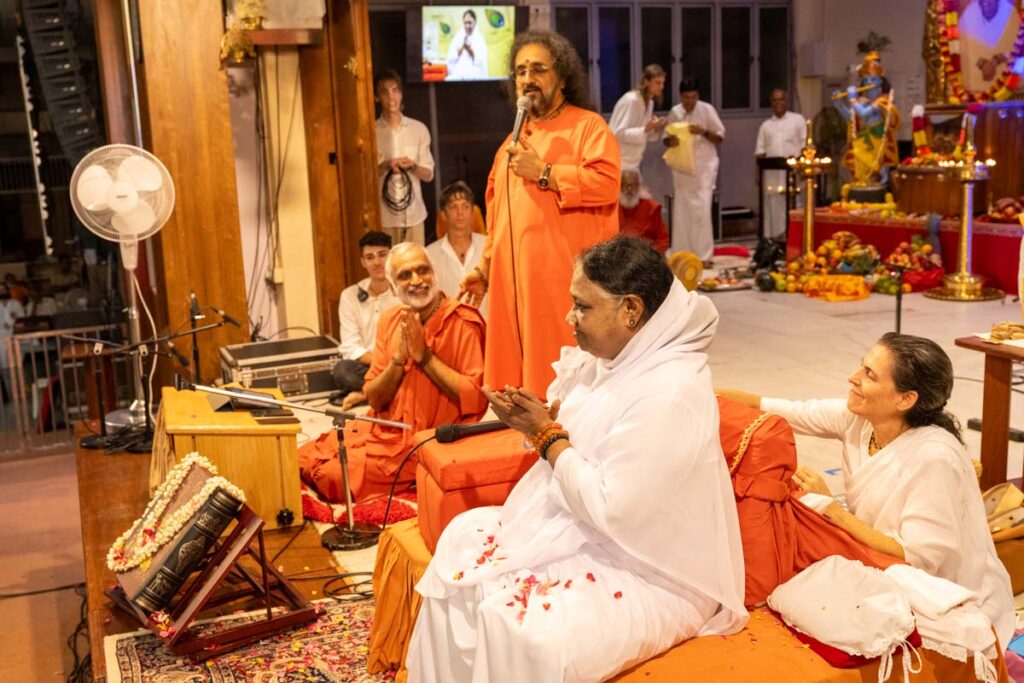
Swami Dhyanamritananda Puri was instrumental in organising all aspects of this massive endeavour. The participants came from diverse backgrounds, including monastics, school students, doctors, trade workers, scientists, musicians—even people who had never heard of the Gita until arriving as visitors in Amritapuri.
“Imagine a garland of 700 flowers all unique in shape, colour, size, and fragrance. Such were the 700 individuals who spoke during this Yajna,” said Swami Dhyanamritananda Puri during the closing ceremonies.
“This was undoubtedly a historic and unique Yajna. One that has probably never happened in the history of the world. Here is why I say this. The participants explained the slokas in their own language and style on this very same stage in Amma’s Divine presence.”
The Gita Yajna was not just a series of talks; it was a catalyst for transformation. Participants shared their personal growth, newfound faith, and a deeper understanding of the Gita’s teachings. It fostered a sense of unity and connection among participants, creating a global spiritual community that transcended borders. The Yajna inspired people to delve deeper into the scripture which in turn brought about realisations and shifts in life perspectives.
“Slokas were expounded in 10 different languages—Malayalam, Sanskrit, Tamil, Telugu, Kannada, Hindi, English, Spanish, French, and Portuguese. People of all ages took part in this Maha Yajna, the youngest being 8-year-old Atmanand and the oldest being 84-years-young Smt Sharadamma from Trivandrum,” said Swami Dhyanamritananda.
“The participants were a mix of Pandits (scholars) and Pamaras (those unfamiliar with the Gita). All of them spoke quoting examples from their own lives. This was Amma’s way of showing us that the Gita is truly universal and accessible to all. She proved that anyone can understand it and live by its values. You don’t need to be a scholar.”
In the end, 11 Swamis, 19 Swaminis, 130 Brahmacharis, 181 Brahmacharinis, 32 children, 38 families, 32 couples, and 160 internationals gave Gita satsang. From India, Canada, Ukraine, Kenya, Turkey, Singapore, USA, Europe, New Zealand, Japan and Chile, people from all corners of the world came forward to explain verses from the Bhagavad Gita in depth. They included ways by which we can practise those teachings in our daily lives.
Swami Dhyanamritananda explained that the methods people chose to share their knowledge reached a broad range of styles. While most presented a traditional discourse, one of the speakers wrote a poem, another performed a monoact, and a musician sang and played her guitar as part of her delivery.
Yet another inspiring factor was the dedication people had to speak when the day of their verse arrived. This included someone who had just been discharged from the ICU, someone with a high fever, someone who postponed chemotherapy sessions, and many who in the end had to deliver their satsangs online. There was even one presenter who stepped in day-of with only five hours to prepare, as the scheduled speaker got COVID.



To the surprise and delight of everyone, the day’s festivities included a satsang by Amritanand, one of the Ashram’s youngest residents. As Swami Dhyanamritananda put it, living proof that through the power of a Satguru, even a 4-year-old can give a talk on the Gita. He recited the first and last verses and then shared his thoughts.
“Sri Krishna gave Arjuna the premappal and jnanappal: milk of love and the milk of knowledge. Wherever Yogeswara Krishna and Arjuna with bow and arrow are present, there will be prosperity, success and righteousness,” said Amritanand.
“Arjuna did fight as per the Lord’s instruction as a tool in His hands. Destroyed all injustice. By continuously chanting the mantra of dear Amma, we can also bind ourselves to her. Chant ‘Om Amma, Om Amma’ to always be with our beloved Amma. We will also be successful.”
Many who listened to the satsangs expressed their gratitude for the opportunity to learn the teachings of the Gita from such a wide range of speakers. In addition to the daily gatherings in Amritapuri, online viewers from more than 40 countries across six continents took part.
“I feel a much deeper connection and understanding of the power of the Gita. Often, I felt as though I was almost hearing the teachings for the first time, because it was woven into personal experiences,” said Kavya Kala Duncan, USA.
“I understood how deep Indian culture is. It has changed my understanding of the nature of the world, what is dharma, the gunas, and the greatness of Lord Krishna,” said Maillet Lalita, France.
“It gave me a realisation that the Bhagavad Gita and Amrita Gita are synonymous. Amma’s life is an embodiment of the teachings. This has deepened my faith in and commitment to spiritual practices,” said Sharon Jones, UK.
To mark an ending to this auspicious gathering of hearts and minds, some of the participants honoured Amma by placing upon her items that symbolise Sri Krishna. This included a yellow silk dhoti, a blue and gold silk shawl, a red silk belt, and a crown with a peacock feather.
All present then joined together to sing the Gita Arati with great humility and gratitude to Amma for imparting this essential knowledge. As Swami Dhyanamritananda waved the Arati lamp, Amma’s message that the Gita is for one and all reverberated in Her expression.
It unfolds diverse paths to uplift people from all backgrounds and experiences—be they full of sorrow or joy—to the realisation of the Self. It is a commentary on the life of Sri Krishna and the Lord’s life is the living commentary on the Gita.
